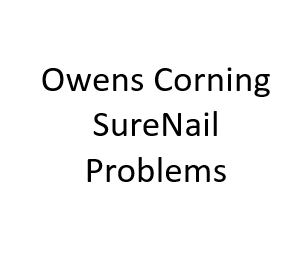Roofing is a vital aspect of any home, offering protection against the elements and enhancing the overall aesthetics. When it comes to roofing materials, Owens Corning is a well-known name, and their SureNail technology has gained popularity in recent years. However, like any roofing system, Owens Corning SureNail isn’t without its issues. In this blog post, we will delve into some common Owens Corning SureNail problems that homeowners and contractors should be aware of.
Understanding Owens Corning SureNail
Before we discuss the problems associated with Owens Corning SureNail, let’s briefly understand what this technology entails. SureNail is a proprietary technology developed by Owens Corning to enhance the performance of their roofing shingles. It involves the use of tough, woven fabric strips embedded in the shingle to provide exceptional gripping power and wind resistance. While this technology has many advantages, it’s essential to be aware of potential issues.
Nail Placement
One of the most common problems with Owens Corning SureNail is related to nail placement. The SureNail strip has a specific nailing line designed to guide installers. However, if contractors fail to follow these guidelines and place the nails too high or too low, it can compromise the integrity of the roofing system.
Nails placed too high might not adequately secure the shingles, making them more susceptible to wind damage. Conversely, nails placed too low can create stress points, potentially leading to shingle blow-offs or damage during temperature fluctuations.
To avoid this issue, it’s crucial for contractors to receive proper training on Owens Corning SureNail installation and follow the manufacturer’s guidelines meticulously.
Delamination
Another concern with Owens Corning SureNail technology is the possibility of delamination. Delamination occurs when the shingle layers separate, compromising the shingle’s strength and durability. While SureNail shingles are designed to resist delamination, improper installation or extreme weather conditions can increase the risk.
To prevent delamination, contractors should ensure that they use the right type and amount of adhesive, especially in areas prone to high winds or temperature variations. Additionally, homeowners should be aware of the warranty coverage provided by Owens Corning and report any signs of delamination promptly.
Shingle Blow-Offs
Shingle blow-offs can be a significant problem associated with SureNail technology, especially if the installation isn’t performed correctly. While SureNail is designed to enhance wind resistance, poor installation practices can undermine this advantage.
Contractors must follow the recommended nailing pattern and use the appropriate number of nails to secure the shingles adequately. Failing to do so can lead to shingle blow-offs during severe weather conditions.
Warranty Concerns
Owens Corning offers warranties on their roofing products, including those featuring SureNail technology. However, homeowners need to be aware that warranty coverage can be affected by improper installation or failure to follow manufacturer guidelines.
If homeowners experience issues with their SureNail roofing, they should document the problems, gather all relevant documentation, and contact Owens Corning or their roofing contractor promptly. In some cases, warranty claims may be denied if installation issues are identified.
Hail Damage
While Owens Corning SureNail technology is designed to resist various weather conditions, including hail, it is not entirely immune to damage from severe hailstorms. Hail can cause impact damage to shingles, leading to cracks, granule loss, and potential leaks. The severity of hail damage can depend on factors such as the size of the hailstones and the age of the shingles.
To mitigate the risk of hail damage, homeowners should consider the impact resistance of their shingles when selecting a roofing product. Owens Corning offers shingles with different levels of impact resistance, so homeowners in areas prone to hailstorms should choose a shingle that best suits their needs.
Algae and Moss Growth
Algae and moss growth can be another concern with Owens Corning SureNail roofing shingles, as they can affect the appearance and performance of the roof. Algae and moss thrive in damp and shaded areas, and if left untreated, they can cause unsightly stains and even damage the shingles.
To prevent algae and moss growth, homeowners should maintain their roofs by keeping them clean and free of debris. In some cases, homeowners may opt for shingles with built-in algae resistance to reduce the risk of growth.
Proper Ventilation
Proper attic ventilation is crucial for the longevity of any roofing system, including those featuring SureNail technology. Inadequate ventilation can lead to a buildup of heat and moisture in the attic, which can accelerate shingle deterioration and even lead to problems like ice dams in cold climates.
Homeowners should ensure their attic spaces are properly ventilated to allow for the free flow of air. Proper ventilation helps regulate temperature and moisture levels, reducing the risk of shingle damage and other roofing issues.
Conclusion
Owens Corning SureNail technology has undoubtedly improved the durability and performance of roofing shingles, making them a popular choice for homeowners. However, like any roofing system, it’s essential to be aware of potential problems and take preventive measures to ensure the longevity of your roof.
To avoid Owens Corning SureNail problems, homeowners should invest in professional installation by certified contractors who are familiar with the technology’s guidelines. Regular maintenance, including cleaning to prevent algae and moss growth and ensuring proper attic ventilation, is also crucial.
By understanding these common issues and taking proactive steps to address them, homeowners can enjoy the benefits of Owens Corning SureNail roofing for many years, ensuring their homes remain protected and aesthetically pleasing.
